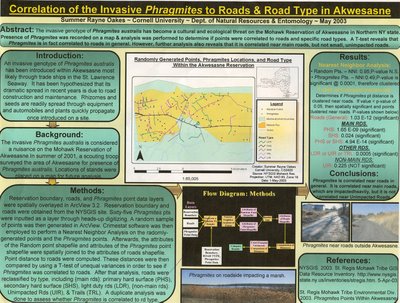Correlation of the Invasive Phragmites to Roads & Road Type in Akwesasne
Published Monday, October 30, 2006 by SROmgmt | E-mail this post I'm breaking this down old school style and whipping out the G.I.S. I was tra-la-la-ing on my old laptop for my Amboseli National Park report and along came my research on the invasive Phragmites (common reed). This was one of the first statistical correlations done to support the theory that invasive species are spread by anthropogenic influences (i.e. road building). I hadn't gotten a chance to get this published, but I do believe my friend used it in his thesis. This really brings back memories out in the field and GPSing this mother f*%ing invasive haplotype. (The Common Reed is native to the U.S., but DNA evidence shows that there is an invasive haplotype from Europe that has invaded the U.S. probably by way of the St. Lawrence Seaway). Why does it all matter? Well, it's your tax dollars baby - this stuff clogs waterways and strangles native fish and bird habitat.
I'm breaking this down old school style and whipping out the G.I.S. I was tra-la-la-ing on my old laptop for my Amboseli National Park report and along came my research on the invasive Phragmites (common reed). This was one of the first statistical correlations done to support the theory that invasive species are spread by anthropogenic influences (i.e. road building). I hadn't gotten a chance to get this published, but I do believe my friend used it in his thesis. This really brings back memories out in the field and GPSing this mother f*%ing invasive haplotype. (The Common Reed is native to the U.S., but DNA evidence shows that there is an invasive haplotype from Europe that has invaded the U.S. probably by way of the St. Lawrence Seaway). Why does it all matter? Well, it's your tax dollars baby - this stuff clogs waterways and strangles native fish and bird habitat.I tried to do a larger correlation outside of the Mohawk Reservation, but unfortunately (like most G.I.S. information), the information wasn't detailed enough. I loved G.I.S. - it kinda gave me the same feeling that I imagine He-Man had when he held his sword up to the lightning, "I HAVE THE POWER!" Unfortunately, being 2 years removed from the technology does not serve one well; I'm not sure I remember much from those days....but oooooohhh how I miss it.
about
- From the frontlines: Tracking the latest news, updates, and projects of Summer Rayne Oakes
previous posts
- Behind the Making of Plastica: Blood Diamonds Shoot
- Behind-the-Scenes at the Ethical Fashion Show, Paris
- Alpacas are cool.
- natur+kosmos feature: interview with Summer Rayne ...
- You're a Rockstar
- NY1's Fortune Business reports on Eco-fashion
- Laure Maud, Lord B and Summer Rayne Oakes for EFS
- French Vogue highlights the Ethical Fashion Show, ...
- Fruits, veggies, and other fine foods = Ethical Fa...
- ONE: End the War on Poverty - NYC Launch
archives
- March 2006
- April 2006
- May 2006
- June 2006
- July 2006
- August 2006
- September 2006
- October 2006
- November 2006
- December 2006
- January 2007
- February 2007
- March 2007
- April 2007
- May 2007
- June 2007
- July 2007
- August 2007
- September 2007
- October 2007
- November 2007
- December 2007
- January 2008
- February 2008
- March 2008
- April 2008
- May 2008
- June 2008
- July 2008
- August 2008
eco fashion sustainable style ecofashion green fashion eco style sustainable design fair trade Summer Rayne Oakes global warming climate change youtube myspace eco organic green balance health wellness environment fashion fashion trends planet style fashion week
0 Responses to “Correlation of the Invasive Phragmites to Roads & Road Type in Akwesasne”
Leave a Reply